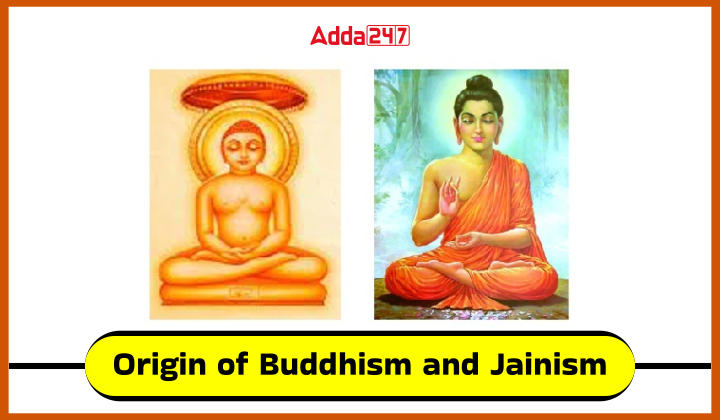Table of Contents
Jainism and Buddhism are two old religions from India that have a lot in common. They started because people wanted different ways to live and see the world. This article will talk about where they came from, what they believe, what they do, and how they are alike. It will also point out the main ways they are different. By looking at their histories and ideas, we can understand more about these important religions and how they’ve influenced Indian culture and beyond. This topic is important to know about, especially for Static GK, as there might be questions about it. Let’s explore more about these two big religions.
Buddhism and Jainism
Jainism and Buddhism are both old religions from India, starting around the same time in the 5th and 6th centuries BCE. They have a lot in common, like believing in non-violence, good behaviour, and spiritual cleanliness. However, they also have some differences. Let’s take a closer look at each one separately.
What is Buddhism?
Buddhism began in ancient India around the 5th century BCE. It was started by Siddhartha Gautama, who became known as the Buddha, meaning “the enlightened one.” Buddhism is built upon the Four Noble Truths, which explain that suffering is a natural part of life but can be overcome by following the Eightfold Path. This path includes things like having the right understanding, intentions, speech, actions, livelihood, effort, mindfulness, and concentration.
What is Jainism?
Jainism, like Buddhism, started in ancient India around the 6th century BCE. It was founded by Mahavira, who is seen as the last and most important of the 24 Tirthankaras, or spiritual leaders, in Jainism.
In Jainism, the core belief is that every living being has a soul, called jiva, and the main aim of life is to attain liberation, known as moksha, from the cycle of birth, death, and rebirth. Jains believe this liberation is possible by following a path of non-violence, called ahimsa, and living a life filled with compassion, honesty, and self-discipline.
Origin of Buddhism and Jainism
- Jainism and Buddhism arose in India during the 6th century BCE in response to the changing social, political, and religious landscape. Both religions opposed the Brahmanical caste system and proposed different ways to break free from the cycle of birth and death, known as samsara.
- Mahavira established Jainism, born around 599 BCE in Bihar to a royal family. At age 30, he abandoned his wealth and dedicated his life to spiritual enlightenment. Jainism advocates liberation through strict adherence to principles like non-violence (ahimsa), truthfulness (satya), non-stealing (asteya), chastity (brahmacharya), and non-possession (aparigraha).
- Siddhartha Gautama, born around 563 BCE in Lumbini (modern-day Nepal) to royalty, founded Buddhism. He relinquished his wealth and status to seek enlightenment. Buddhism teaches liberation through the Eightfold Path, which includes right understanding, intention, speech, action, livelihood, effort, mindfulness, and concentration.
- Both Jainism and Buddhism challenged Brahmanism’s dominance, rejecting the authority of the Vedas, and its sacred texts, and offering alternative paths to spiritual freedom. They emphasized ethics and morality, leaving a profound impact on Indian society and culture.
Teaching of Buddhism and Jainism
Below are the fundamental teachings of both religions. Candidates can take a look at each to learn more about them.
Teachings of Buddhism:
- Four Noble Truths: Buddhism teaches that all life involves suffering (dukkha) and offers the Four Noble Truths as a path to overcome it. These truths include recognizing suffering, understanding its cause, realizing it can end, and following the path to end it.
- Eightfold Path: Buddhism presents the Eightfold Path as a way to achieve freedom from suffering. This path comprises the right understanding, intention, speech, action, livelihood, effort, mindfulness, and concentration.
- Karma: Buddhism acknowledges karma, the idea that actions have consequences affecting present and future lives.
- Non-Self (Anatta): Buddhism teaches that there’s no permanent self or soul; rather, the self is ever-changing and composed of different elements.
- Impermanence (Anicca): Buddhism emphasizes impermanence, stating that everything is in constant flux. Recognizing this impermanence helps alleviate suffering.
Teachings of Jainism:
- Non-Violence (Ahimsa): All living things, including plants and animals, are subject to non-violence in Jainism. It is regarded as the greatest virtue and is essential to emancipation and spiritual purity.
- Self-Control (Sanyam): Jainism advocates self-control in thoughts, words, and actions. The aim is spiritual purity and breaking free from the cycle of birth and rebirth.
- Non-Attachment (Aparigraha): Jainism stresses the need to detach from material possessions and desires, as attachment leads to greed and negative karma.
- Karma: Jains believe in karma, where actions, thoughts, and intentions accumulate consequences. Good deeds bring positive karma, while bad ones lead to negative karma.
- Liberation (Moksha): Jainism’s ultimate goal is liberation from the cycle of birth and rebirth. Achieving this requires practising non-violence, self-control, and non-attachment.
Principles of Buddhism and Jainism
To help you understand the Origin of Buddhism and Jainism principles, the core ideas of each are listed here. Study these to learn more about these faiths.
| Principles of Buddhism and Jainism | ||
| Principle | Jainism | Buddhism |
| Non-Violence | Emphasizes non-violence towards all living beings | Teaches non-harm and compassion towards all beings |
| Self-Control | Focuses on self-control and discipline | Emphasizes the cultivation of ethical behavior |
| Non-Attachment | Encourages non-attachment to material possessions | Encourages detachment from desires and craving |
| Karma | Believes in the accumulation of karmic consequences | Believes in the concept of karma and its effects |
| Liberation | Seeks liberation from the cycle of birth and rebirth | Seeks liberation from suffering through enlightenment |
| Meditation | Practices meditation to cultivate spiritual awareness | Practices meditation to cultivate mindfulness and wisdom |
| Enlightenment | Emphasizes self-realization and spiritual purity | Emphasizes the attainment of enlightenment |
Difference between Buddhism and Jainism
Their numerous differences between Buddhism and Jainism, however, some of them are too similar. Through the below table, you will find out those differences easily.
| Difference between Buddhism and Jainism | ||
| Aspect | Buddhism | Jainism |
| Founder | Siddhartha Gautama (Buddha) | Mahavira |
| Origin | India | India |
| Belief in God | No belief in a supreme being | No belief in a supreme being |
| Karma | Central concept but not as emphasized | Central concept |
| Reincarnation | Central concept | Central concept |
| Goal | Enlightenment | Liberation from suffering |
| Non-violence | Principle | Principle |
| Ahimsa | Emphasized in real life | Emphasized in real life |
| Vegetarianism | Practiced by some Buddhists | Practiced by many Jains |
| Scriptures | Tripitaka | Agamas |
| Path | Eightfold path | Threefold path |
| Meditation | Emphasized | Practiced but not emphasized |
Similarities of Buddhism and Jainism
Listed below are the similarities between Jainism and Buddhism, notably their focus on non-violence and the significance of ethical conduct. Moreover, both religions are rooted in a shared cultural and historical heritage originating in India.
| Similarities Between Buddhism and Jainism | ||
| Similarities | Jainism | Buddhism |
| Non-violence | Jainism places a strong emphasis on ahimsa, the principle of non-violence towards all living beings | Buddhism also teaches the principle of non-violence and considers it a fundamental aspect of spiritual practice |
| Karma | Both religions believe in the concept of karma, where an individual’s actions have consequences that affect their future lives or rebirths | Both Jainism and Buddhism believe that one’s actions (karma) determine the quality of one’s rebirth |
| Meditation | Both religions emphasize the practice of meditation as a means of attaining spiritual enlightenment or liberation | Both Jainism and Buddhism have developed different types of meditation practices |
| Rejection of Vedas | Both religions reject the authority of the Vedas, the oldest sacred texts of Hinduism | Both Jainism and Buddhism reject the caste system and emphasize the importance of individual effort and self-reliance |
| Renunciation | Both religions advocate for the renunciation of worldly pleasures and detachment from material possessions | Both Jainism and Buddhism emphasize the importance of practicing self-discipline and controlling one’s desires in order to achieve spiritual liberation |



 Bishnoi Movement - History, Objective, a...
Bishnoi Movement - History, Objective, a...
 Neolithic Age- Agriculture, Tools, Potte...
Neolithic Age- Agriculture, Tools, Potte...
 Position of Women in Vedic Age: Societie...
Position of Women in Vedic Age: Societie...




